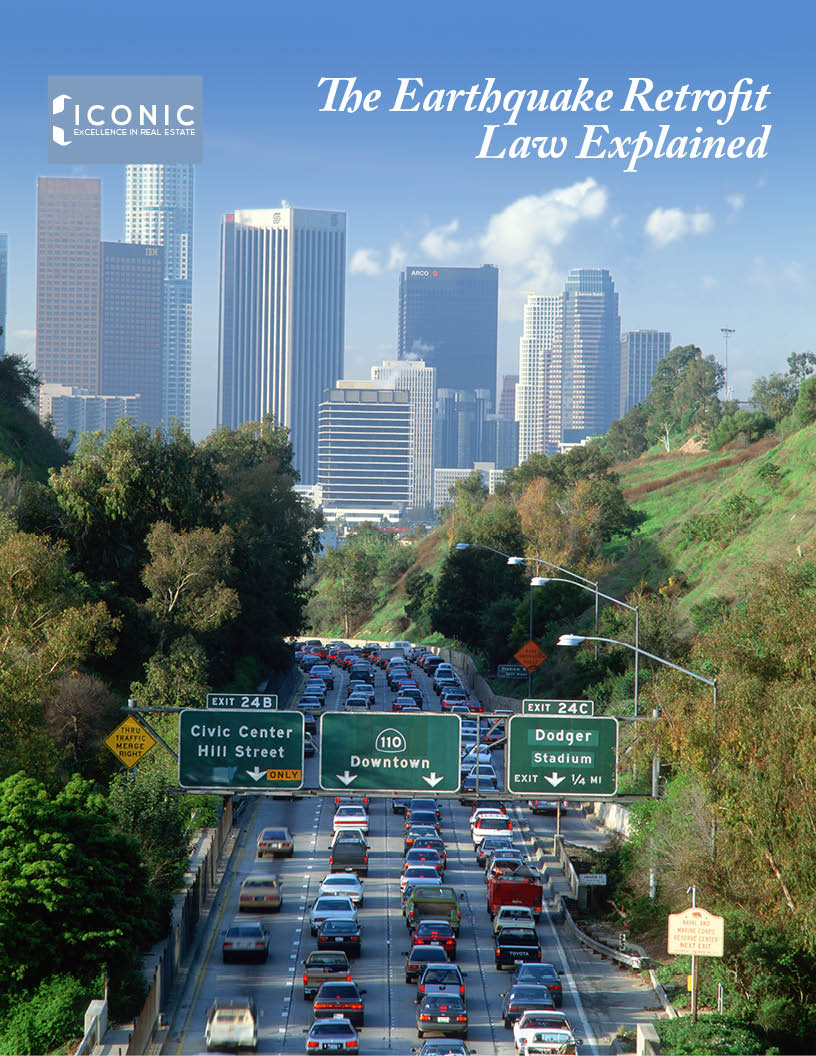City Approves Developer Linkage Fee
UCLA 2018 Economic Forecast
How Koreatown Evolved Into A Development Hot Spot
Iconic Lists - Sanctuary on Kingsley Development Opportunity
Iconic Investments has listed for sale, Sanctuary on Kingsley, a development opportunity in LA's Koreatown submarket. The parcel of land located at 328 N. Kingsley Drive is 28,370 square feet and zoned R3-1. While the current improvements on the property are 20 apartment units, a developer can build up to 48 units
True Costs of Selling an Apartment Building
As you consider selling your investment property, it is essential that you have a clear understanding of what your net proceeds will be at the close of escrow. We will outline typical costs sellers are responsible for, and other costs that are open for negotiation with the buyer. This guide allows you to estimate your net proceeds.
AppFolio- Management Software Review
UCLA Economic Forecast December 2016
Iconic Investments attended the UCLA Anderson Forecast presentation on December 6, 2016. The main theme of the 2017 forecast was “Trumponomics” - how Donald Trump's fiscal policy will affect the US economy, and the elements of his plan. Post-Election, the financial markets have seen an immediate and sharp rise in the stock indices,
Koreatown Apartment Developers Bring More Retail, Higher Rents for All Owners
Currently in Koreatown, there are more than 5,000 apartment units with 200,000 sq ft of retail either under construction or planned. Most of the projects are ground-up construction, while some developers are converting existing office buildings into apartments. Developers of the new projects expect a stabilized cap rate of 5.5%
Earthquake Retrofit Law Explained
Introduction
In October 2015 the Los Angeles City Council unanimously approved one of the nation’s toughest retrofitting ordinances, mandating seismic upgrades aimed at improving earthquake safety in over 14,000 buildings throughout the city. This ordinance directly affects owners and tenants of apartment buildings built prior to 1978 with soft, open, or weak wall lines. This typically corresponds to building sections supported by slender columns with larger tuck-under parking at the ground level. These properties have been deemed to be most at risk in an earthquake event.
In this guide, we’ll help you to understand if and how this ordinance may affect you and your tenants, and how to navigate the complex process of compliance. We believe every owner should be informed.
Overview
Why the proposed law?
Moderate to severe earthquakes are common in Los Angeles and throughout California. The 1994 Northridge earthquake killed 57 people, many resulting from collapses of soft-story apartment buildings, and caused approximately $20 billion in damage. At the time it was considered to be one of the deadliest and most expensive natural disasters in US history.
The likelihood of another major earthquake occurring in Los Angeles is high, and city officials want to minimize both the potential for loss of life and economic impact. City officials acknowledge it is not a question of if, but when.
Who will it affect?
The Los Angeles City Council and Mayor Garcetti’s office recently approved a mandatory seismic strengthening ordinance that affects two groups of buildings known to be vulnerable to earthquake damage. These are:
- Wood framed multi-family buildings with areas of tuck- under parking - with soft line or weak line configurations - that were constructed under permits filed before January 1, 1978.
- Non-Ductile Concrete Buildings constructed prior to January 13, 1977
The “soft story” or soft line/weak line building configuration is common to apartment buildings in Los Angeles, and is known to be especially vulnerable to earthquake damage and potential collapse. The proposed ordinance will require landlords to reinforce and strengthen these properties. The Los Angeles Department of Building and Safety has so far pre-identified approximately 13,000 buildings within the city limits that have a condition.
The ordinance, which is now law, requires owners of vulnerable buildings to complete seismic upgrades within 7 years once they are notified that their buildings must be strengthened. Within 2-years after service of the order the Building Owner must submit to the Building Department a structural analysis and/or plans that demonstrate compliance or include the proposed structural alteration to meet the requirements of Division 93. Within 31⁄2-years after service of the order, property owners must obtain all necessary permits for rehabilitation or demolition.
When will owners be notified?
The ordinance, in it’s current form, has designated priorities to help in the implementation and enforcement. These priorities focus on buildings presenting greatest risk to loss of life first. The priorities are as follows:
Priority I: Buildings with 16 or more units;
Priority II: Buildings with 3 or more stories, and 16 or less units;
Priority III: Buildings not falling under the definitions of Priority I or II.
It is important to note that, once an owner is given notification of retrofit requirements on their property, a notice of work required is recorded on title.
What's involved?
A SWOF (Soft, Weak or Open Front) retrofit will typically include the addition of steel moment frames along the open parking areas and are designed to not obstruct the existing parking. Walls surrounding the parking areas may require strengthening with plywood structural panels before new finishes or stucco is re-applied.
How much will it cost?
The cost of such retrofits vary widely and will likely range between $30,000 to $250,000 for wood-frame buildings, and likely over $1 million for concrete structures.
Costs are totally dependent on the specific building configuration and scope of work. Construction durations for soft-line strengthening are often 60-days (+/-) and must be carefully planned to avoid tenant relocation or habitability disruptions.
The design, acquisition of building permits, tenant notifications, and construction coordination can be compressed into 6-months but often take longer due to variables.
What are the current codes?
The building codes currently in force 2014 LABC and 2013 CBC do not provide perfect guidance to Engineers on how to address SWOF conditions. Additionally, there are a variety of methodologies in existance to improve building strength and stability. This has been a source of confusion among practicing structural engineers and building officials.
The ordinance draws from model codes but is expected to only target localized SWOF deficiencies and not the entire building (except in rare cases) - thereby limiting the scope and the costs. The performance outcome is to create a more earthquake resilient Los Angeles.
Are there any financing options?
New funding and financing options are developing such as:
A proposal is currently before the City Council that would allow owners of rent controlled properties subject to the ordinance to pass a portion of the costs to tenants through a rental increase. The exact dollar amount and time-frames have not yet been finalized, but the Council is debating a rate of between $38 and $50 per month for five or seven years. At best, this option will allow owners to recapture some of the actual costs associated with retrofit.
Property owners may also elect to pursue creative financing solutions - essentially secondary loans - available through lending programs that include the AllianceNRG PACE.
Governor Brown recently vetoed AB428, a bill which would have provided owners with a 30% tax break on the costs of retrofit. New legislation may arise to fill this gap.
Press Release- Iconic Investments sells Sherman Apartments
LA's apartment market is so hot, even a building that's 42% vacant with zero cash flow can find a buyer like Lion Real Estate Group, which snapped up the 60unit Sherman Apartments with plans to renovate the Koreatown property for urban professionals. The property traded at a 1.34% cap rate on inplace rents.
Both sides were represented by Iconic Investments' Peter Strauss, who tells us the biggest hurdle wasn't the building's vacancy but rather the extensive work required. The buyer needs to gut 23 units down to the studs and put in all new systems: plumbing, electrical, roofing. "This wasn't just an apartment building with a large number of vacancies. This was literally a construction project." Every major buyer in LA looked at the property, he says. "We had over 20 property tours that yielded seven offers, and led to a bestandfinal pool of three buyers." Lion, which owns and operates more than 600 units in LA, plans to spend $1.2M on improvements in order to reposition the property to appeal to young urban professionals. Rents average $650 to $750 for a studio unit, likely increasing to the $1,095 to $1,195 range after everything's done, but he expects it will be six to 12 months before the buyers see any cash flow.
Sherman Apartments' seller, a Commerce based private investor, owned the building for more than 40 years. The property was built in 1926 and is near three Metro stations in a gentrifying area of Koreatown, Peter says. He's seeing large numbers of people relocate to LA from New York and Boston for work, and these folks are accustomed to riding the subway. “To live in Koreatown just feels right, and they get these beautiful 1920s properties similar to what they had back east.” Peter's family includes wife Paula, son Ethan, and the newest addition: onemonthold daughter Ruby.









